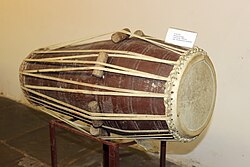
Back পাখোয়াজ Bengali/Bangla Pakhavadž Czech Pakhawaj German Pakhawaj Spanish पखावज Hindi പഖവാജ് Malayalam पखवाज Marathi Pakhavaj Dutch ਪਖਾਵਜ Punjabi Pakhawadź Polish
 | |
| Percussion instrument | |
|---|---|
| Related instruments | |
| Mridangam, khol, tabla, kendang, jori (instrument) | |
| More articles or information | |
| Hindustani music |
The pakhavaj is a barrel-shaped, two-headed drum, originating from the Indian subcontinent,[1] the oldest version of double sided drums and its descendants are mridangam of Southern India and kendang of Maritime Southeast Asia and other South Asian double-headed drums. Its older forms were made with clay.
It is the percussion instrument most commonly used in the dhrupad style of Indian classical music and less often used as a rhythm accompaniment for various other sub-forms of music and dance performances (e.g. kathak, odissi, marathi). It has a low, mellow tone that is quite rich in harmonics. The sides of the pakhawaj are made with animal skin (often goat skin). The pakhavaj players place the instrument horizontally in front of themselves as they sit on the floor with legs crossed. The players may sometimes place a cushion under the narrower treble face to lift it slightly. A right-handed person places the larger bass-skin on the left side and the treble skin on the right. The bass face tends to be smeared with some fresh wheat dough which acts as the kiran and gives a vivid bass sound to the pakhavaj.
The tuning of Pakhavaj is similar to that of the tabla – with the wooden wedges placed under the tautening straps. Due to the varied thickness of the skin that covers the treble face, the treble face can produce at least two tones that are a semitone apart. For example, if hitting the centre (the bol दिन din) is tuned to produce the note C then hitting closer to the edge (with the bol ता for example) could produce the note C#. The fine tuning can be done with the woven outer ring (गजरा – gajra) which is an extension of the skin that the face is made of. It is only on the bass skin where a freshly made batter (or dough) of (wheat) flour and water is applied to provide enhance the low-pitched sound.[2] While the options to use a polymer-based substitute are available but are not commonly used.
- ^ James Blades (1992). Percussion Instruments and Their History. Bold Strumme. pp. 138–. ISBN 978-0-933224-61-2. Retrieved 25 December 2012.
- ^ Pakhavaj, Tuning. "Tuning Pakhavaj". indian-instruments.com. (N.A.). Retrieved 10 November 2017.